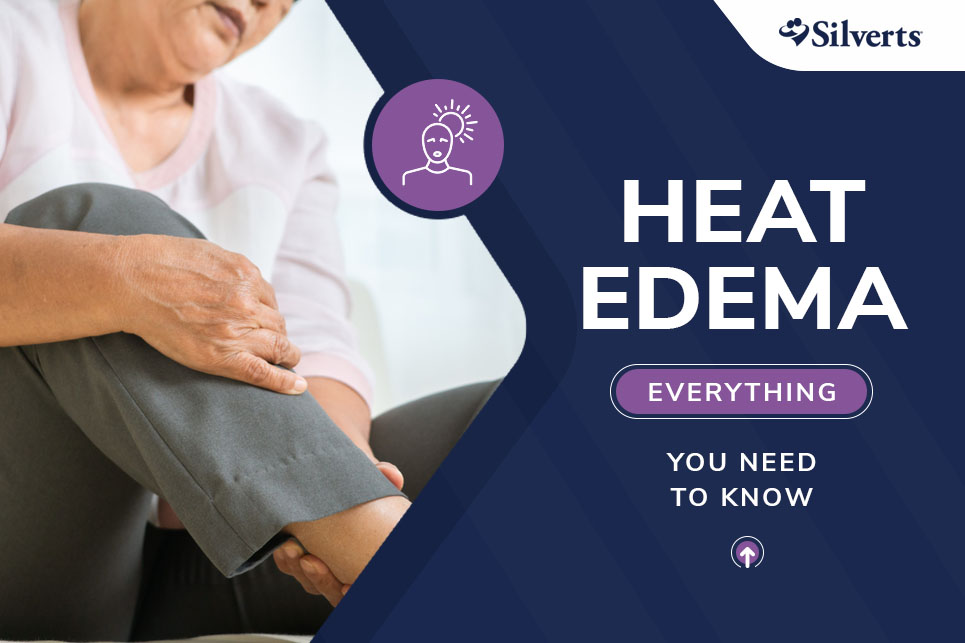Heat Edema: Everything You Need to Know
Is a heat edema dangerous for older adults? Heat edema is a condition that occurs when heat exposure causes swelling. It is relatively common in the summer, especially among the elderly. In this ultimate guide, we are exploring everything that you need to know about heat edema, from what causes it to how to prevent it.
While you’re at it, check out our guide to the . Our guide will help you stay safe and comfortable this summer while still enjoying the benefits of the warmer weather.
What is heat edema?
Edema is the medical word for swelling. Edema occurs when the tiny capillaries in the body leak fluid, which builds up in nearby tissues. Heat edema specifically refers to swelling that occurs from exposure to heat. Heat edema often manifests in the lower extremities but can appear all over. People more commonly experience heat edema during the summer and in hot climates.
What causes heat edema?
Heat causes the blood vessels in your body to expand (dilate), allowing the blood to flow more easily. Gravity pulls the blood and other fluids down into the feet and legs, causing swelling. This increased blood flow may also cause extra fluids to leak out of the tiny capillaries in your lower extremities, further exacerbating the swelling. Heat edema can also be related to temperature regulation. When you get hot, your body tries to circulate warm blood away from your torso. This blood ends up in the extremities, mostly the feet and legs because of gravity, resulting in swollen feet.

Risk Factors for Heat Edema
Certain factors make you more likely to develop heat edema during the summer. For one, if you live in a colder climate and travel to a warmer climate on vacation, then you might experience heat edema as your body struggles to acclimate to the warmer climate. Your body doesn’t know how to regulate temperature in a warmer climate, potentially leading to heat edema. Being outside or otherwise exposed to hot temperatures can also cause heat edema, even if you typically live in a hot climate. This is especially true on very hot, very humid days when the temperatures rise.
Long periods of sitting or standing can also lead to edema, including heat edema. If you’re not moving around, then your blood isn’t circulating as fast, and gravity can cause fluids to pool in your lower body if you sit or stand for long periods of time. Couple that with hot temperatures — like, say, sitting on a warm beach for many hours — and you might find your feet and legs swelling with heat edema.
Elderly people are more at risk for heat edema than younger people. This is because your body becomes less skilled at regulating temperature as you age so elderly people are more prone to heat exhaustion. Their blood vessels also don’t dilate as efficiently, which can lead to fluid retention and high blood pressure. Some elderly people also lose their sense of thirst and may become dehydrated without realizing it.
Multiple health conditions are known to increase the risk of heat edema. For instance, people with heart disease are unable to pump blood properly, while diabetes damages small blood vessels due to too much glucose in the blood. Kidney disease impairs the kidneys’ ability to filter the body’s fluids, resulting in swelling.
Certain types of medications increase the risk of all types of swelling, including heat edema. Some medications to watch out for include nonsteroidal anti-inflammatory drugs (NSAIDs), antihypertensive drugs, steroids, estrogen and antidiabetic drugs. Talk with your doctor if you think that one of your medications might be causing heat edema as a side effect.
Pregnancy also causes more swelling and makes you more vulnerable to heat edema. During pregnancy, the body produces more blood and other fluids, resulting in swelling. Pregnant women are also more at risk of other heat-related illnesses, including heat edema, because their bodies must work harder to cool down both them and the developing baby. As the fetus grows, it puts more pressure on the inferior vena cava, impairing blood flow back to the heart and making swelling worse.
Smoking also makes you more susceptible to heat edema. That’s because smoking damages your blood vessels and also causes chronic inflammation, which both contribute to swelling. If you are exposed to secondhand smoke, do what you can to limit your exposure. If you currently smoke, seek out resources to help you quit.

Symptoms of Heat Edema
The first sign of heat edema is swelling. This typically appears in the arms or legs and may affect just one limb or both limbs at a time. This fluid retention often becomes more noticeable as the day goes on. The skin may appear stretched by the swelling beneath it, and it may take on a shiny appearance. Most mild cases of heat edema that involve these symptoms can be treated at home.
If you press your finger into the swollen area, the indentation may linger instead of the skin bouncing back like normal. This type of edema, known as pitting edema, can range from mild to severe. If you can create a very deep depression, or the indentation takes more than a few seconds to spring back, then you might need medical attention or prescription medications to treat your edema.
As the edema progresses, it may make it difficult to walk or otherwise impact mobility. Some people also experience headaches, lightheadedness, shortness of breath and/or difficulty urinating as the edema gets worse. If you have been trying to treat your edema at home and your symptoms are getting worse, reach out to your medical provider for guidance, since it might be a symptom of a more serious underlying health problem.
Some people may also experience pain in the affected areas, which can be a signal of deep vein thrombosis (DVT), a potentially fatal condition. DVT occurs when a blood clot forms in veins deep in your body. If the blood clot breaks free and becomes loaded in the lungs, it will cause a pulmonary embolism (PE), which can be life threatening. If you are exhibiting symptoms of DVT, seek medical attention immediately.

Discover All of Our Adaptive Footwear
How to Prevent Edema
One of the most important things that you can do to avoid heat edema is to limit heat exposure. If it’s summer or you live in a hot climate, try to stay inside when possible. Turn on the air conditioning or run fans to cool yourself off. If you must get outside, avoid the hottest hours in the middle of the day. Instead, go outside in the early morning or late evening hours when the weather is cooler. Stay in the shade and wear a wide-brimmed hat to help yourself stay cool.
Wearing compression stockings can also help to prevent edema. Compression socks put gentle pressure on your feet and legs to promote better circulation and discourage the blood vessels from expanding. For best results, the compression stockings should be donned first thing in the morning, before your feet and legs have a chance to swell.
Most people will find that either low compression or medium compression stockings are helpful for their heat edema. Moderate compression and firm compression stockings are usually reserved for those with more advanced health problems.
Try to avoid standing for long periods of time; take frequent breaks to sit in a cool spot whenever possible. However, you should also avoid sitting in the same position for long periods of time as well. Try to get up and move at least once an hour to boost your blood circulation. Incorporating regular physical exercise into your routine will also help to strengthen your cardiovascular system and increase your circulation overall. Just to be sure to stay cool while you exercise, since working out in the heat can cause heat-related illnesses!
Drinking enough water is important for treating edema, since your body will retain excess fluids if you are dehydrated. Rather than gulping a bunch of water at once, take small sips throughout the day to promote better absorption. Try to eat a diet that is low in sodium and salt; having too much sodium in your system can cause your body to retain fluid as well. Also try to limit your consumption of foods and beverages that can cause inflammation and swelling, especially those high in sugar, fat, caffeine or alcohol.
Avoid constricting clothing, which can impede blood flow and make the swelling worse. Instead, choose loose, breathable clothing such as nightgowns for women that will let your blood circulate freely. The clothing should be in lightweight colors that won’t absorb sunlight and will help to keep you cool. You should also choose adjustable, wide slip-on shoes for the elderly that can be loosened to accommodate swelling so that they won’t cut into your feet. Check out our list of the best shoes for swollen feet to get your search started.
Take your medications as prescribed and reach out to your doctor if you think that one of them might be causing your heat edema. Don’t suddenly stop taking medication or skipping doses without first consulting your doctor.

How to Treat Heat Edema
In many cases, taking the preventative steps that we listed above will help to prevent heat edema. However, sometimes you will find yourself experiencing heat edema before you’ve had a chance to stop it. Thankfully, most mild cases of heat edema can be treated at home.
If you notice that you are experiencing heat edema, you should first relocate somewhere that is cool, ideally somewhere inside with air conditioning. You may wish to take a cold shower or bath to help yourself cool down or run a fan to get air circulating. You can also apply ice packs or cold compresses to the swollen areas to help bring down the swelling.
Once you are feeling cool enough, try lying down on your back and elevating your feet on two to three pillows. This will encourage the fluids in your legs to drain back toward your core, lessening the swelling. Try to lie this way for at least 15 minutes, and it may take longer for the swelling to go down. You can also try gently massaging your legs while either lying down or sitting up.
If you are feeling up to it, try moving your body around, such as going for a little walk about the house or doing a gentle yoga routine. This heat therapy will get the blood pressure flowing and help the fluids to drain. Don’t sit or stand in the same position for too long; change things up to stop the blood from pooling in your lower body.
If your heat edema persists, your doctor might prescribe a medication that helps the body expel excess fluid through urine. Some examples of these medications include furosemide (Lasix), Aldactone, metolazone, Aldactazide, Demadex and Maxzide. If your heat edema persists, then you should reach out to a medical provider for treatment. In some cases, heat edema can be a symptom of an underlying health condition — sometimes a serious one. Getting treatment for the underlying health condition should help the heat edema resolve itself.
Looking for clothing and shoes that will help you beat the heat this summer? Browse the Silverts online store to find all the senior clothing that you need.
Image Credits
Impixdesign/Shutterstock.com
Marina Shevchenko/Shutterstock.com
fizkes/Shutterstock.com
comzeal images/Shutterstock.com
Andrey_Popov/Shutterstock.com
BEAUTY STUDIO/Shutterstock.com





No Comments